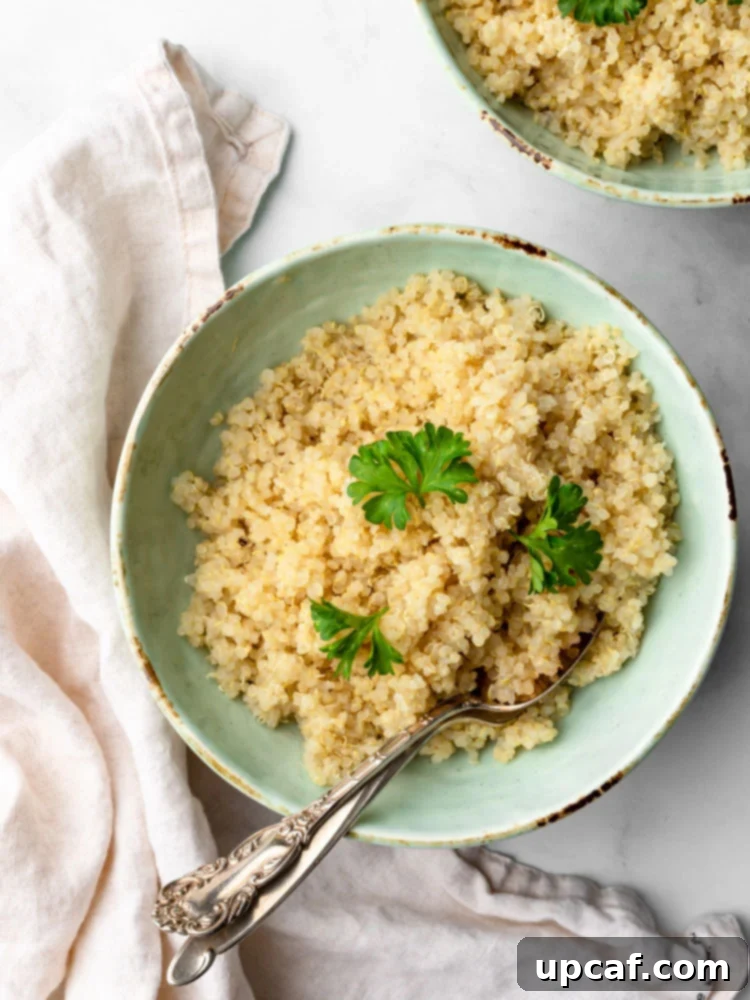Master the Art of Cooking Quinoa: Your Comprehensive Guide to 4 Easy Methods and Health Benefits
Embark on a culinary journey to master quinoa, the ancient superfood that’s become a staple in modern healthy kitchens. This comprehensive guide will transform you into a quinoa-cooking pro, showing you four distinct methods – stove top, rice cooker, Instant Pot, and microwave – ensuring perfectly fluffy results every time. Whether you’re a seasoned meal prepper or new to this nutritious grain, you’ll discover how effortlessly quinoa integrates into a healthy lifestyle, providing a versatile base for countless delicious dishes.
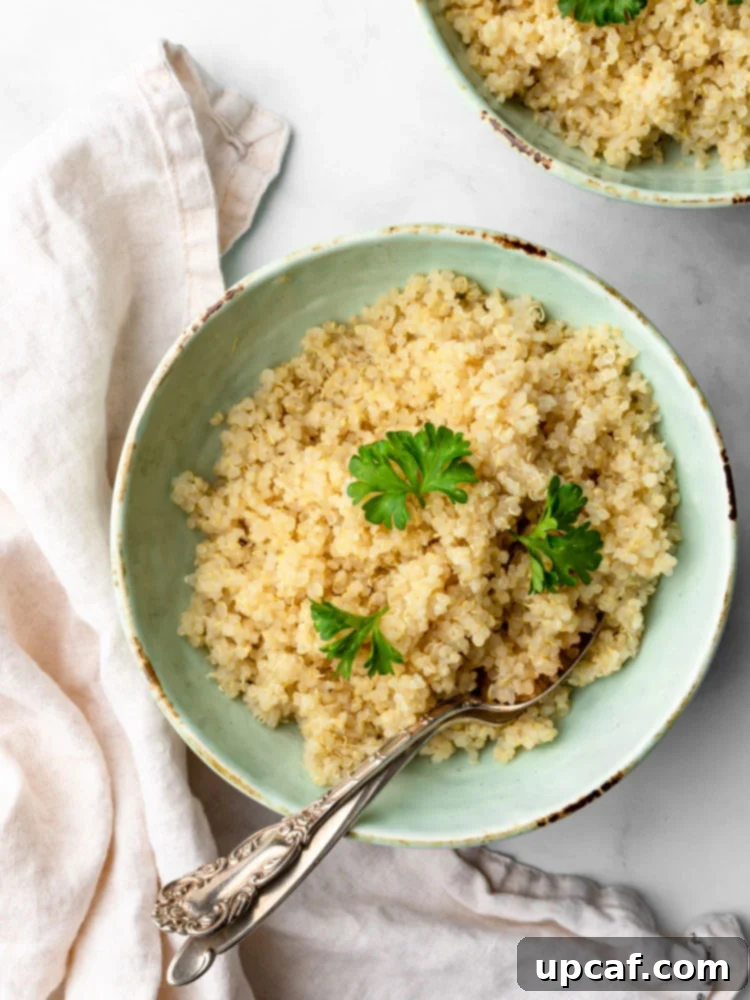
What Exactly is Quinoa? The Ancient Seed with Modern Appeal
Often mistaken for a grain, quinoa (pronounced “KEEN-wah”) is technically a seed from the *Chenopodium quinoa* plant, making it a “pseudo-cereal.” Originating in the Andes region of South America, it has been cultivated for thousands of years, primarily in Peru, Bolivia, Ecuador, and Chile. To the ancient Incas, quinoa was a sacred crop, revered as “the mother of all grains” and believed to impart strength and stamina. Its resilience in harsh climates and remarkable nutritional profile made it a cornerstone of their diet.
In the last decade, quinoa has experienced a phenomenal resurgence in popularity worldwide, celebrated for its versatility, gluten-free nature, and impressive health benefits. It offers a subtle, nutty flavor and a pleasingly fluffy texture when cooked, making it an excellent alternative to rice or couscous in a variety of dishes.
Exploring the World of Quinoa: Varieties and Their Uses
While the quinoa plant boasts an astonishing 3,000 different cultivars, only a handful are widely available in grocery stores. The most common types you’ll encounter are white, red, and black quinoa, along with a popular tricolored blend that combines all three. Each variety offers slightly different characteristics in terms of flavor, texture, and cooking time, which can influence their best culinary applications.
- White Quinoa: This is the most common and mildest variety. White quinoa cooks up the fluffiest, making it an excellent substitute for rice. Its delicate flavor allows it to easily absorb other seasonings and sauces, making it incredibly versatile for almost any dish.
- Red Quinoa: With a slightly earthier and nuttier flavor than white quinoa, red quinoa also has a chewier texture. It tends to hold its shape better after cooking, making it ideal for salads where you want the grains to remain distinct and not clump together. It also adds a beautiful pop of color to your plate.
- Black Quinoa: The boldest in flavor and firmest in texture, black quinoa boasts an even nuttier and slightly sweeter profile than its red counterpart. It has the longest cooking time of the three and maintains a satisfying crunch. Black quinoa is fantastic in hearty salads, as a side dish, or anywhere you desire a more pronounced flavor and textural contrast.
- Tri-color Quinoa: This blend typically combines white, red, and black quinoa, offering a balanced profile of flavors and textures from all three. It provides a visually appealing mix and a comprehensive nutritional boost.
Unlocking Quinoa’s Nutritional Powerhouse: The Benefits You Can’t Ignore
Beyond its ancient roots and culinary versatility, quinoa truly shines as a nutritional superstar. It’s often hailed as a “superfood” for good reason, offering a dense array of vitamins, minerals, and essential macronutrients that support overall health.
- Complete Protein Source: Unlike most plant-based foods, quinoa is a complete protein, meaning it contains all nine essential amino acids that the human body cannot produce on its own. A single cup of cooked quinoa provides approximately 8 grams of high-quality protein, making it an invaluable food for vegetarians, vegans, and anyone looking to boost their protein intake. This complete amino acid profile is crucial for muscle repair, enzyme function, and overall bodily processes.
- Rich in Dietary Fiber: With about 5 grams of fiber per cooked cup, quinoa supports digestive health, helps regulate blood sugar levels, and promotes a feeling of fullness, which can aid in weight management. The fiber content in quinoa is a mix of soluble and insoluble fiber, both vital for gut health.
- Abundant in Essential Minerals: Quinoa is an excellent source of several crucial minerals. It’s particularly high in:
- Manganese: An antioxidant that plays a key role in metabolism and bone health.
- Magnesium: Essential for nerve and muscle function, blood sugar control, and blood pressure regulation.
- Phosphorus: Important for strong bones and teeth, as well as energy production.
- Iron: Crucial for oxygen transport in the blood and energy levels, making quinoa a great non-heme iron source for plant-based diets.
- Zinc: Supports immune function, wound healing, and DNA synthesis.
- Packed with Antioxidants: Quinoa contains powerful plant compounds like quercetin and kaempferol, which have antioxidant and anti-inflammatory properties. These antioxidants help protect cells from damage by free radicals, potentially reducing the risk of chronic diseases.
- Naturally Gluten-Free: Quinoa is naturally gluten-free, making it a safe and nutritious grain alternative for individuals with celiac disease or gluten sensitivity. Its high nutritional value makes it a superior option compared to many other gluten-free alternatives.
- Non-GMO and Often Organic: Due to its natural resistance to pests (thanks to its saponin coating, which we’ll discuss next!), quinoa is relatively easy to grow organically, and the vast majority of commercially available quinoa is non-GMO.
Essential Prep: The Crucial First Step Before You Cook Quinoa
The Importance of Rinsing Quinoa
Regardless of your chosen cooking method, the most critical step before cooking quinoa is rinsing it thoroughly. Quinoa seeds are naturally coated with a bitter compound called saponin, which serves as a natural pest deterrent. While many commercially packaged quinoas are pre-rinsed, an additional rinse at home is always recommended to ensure you remove any residual saponin. Skipping this step can result in a noticeably bitter or soapy taste in your cooked quinoa.
- Pour the desired amount of quinoa into a fine-mesh colander or sieve.
- Rinse under cold running water for at least 30-60 seconds, gently agitating the quinoa with your fingers, until the water runs completely clear. You might notice a light foam during the initial rinse – this is the saponin.
- Drain thoroughly before cooking.
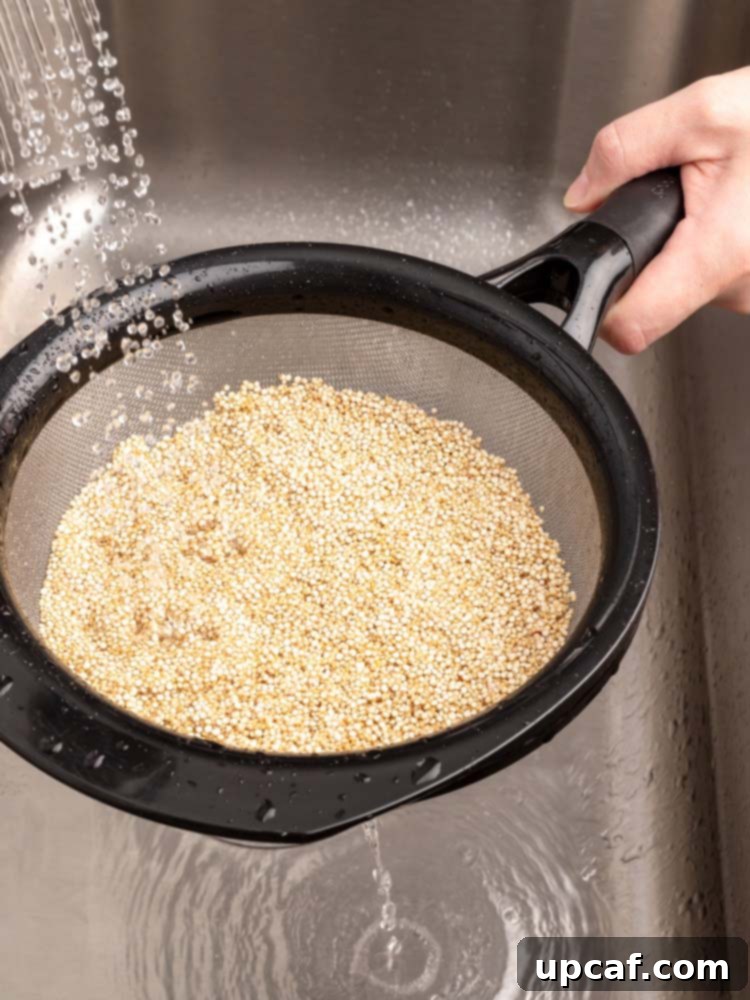
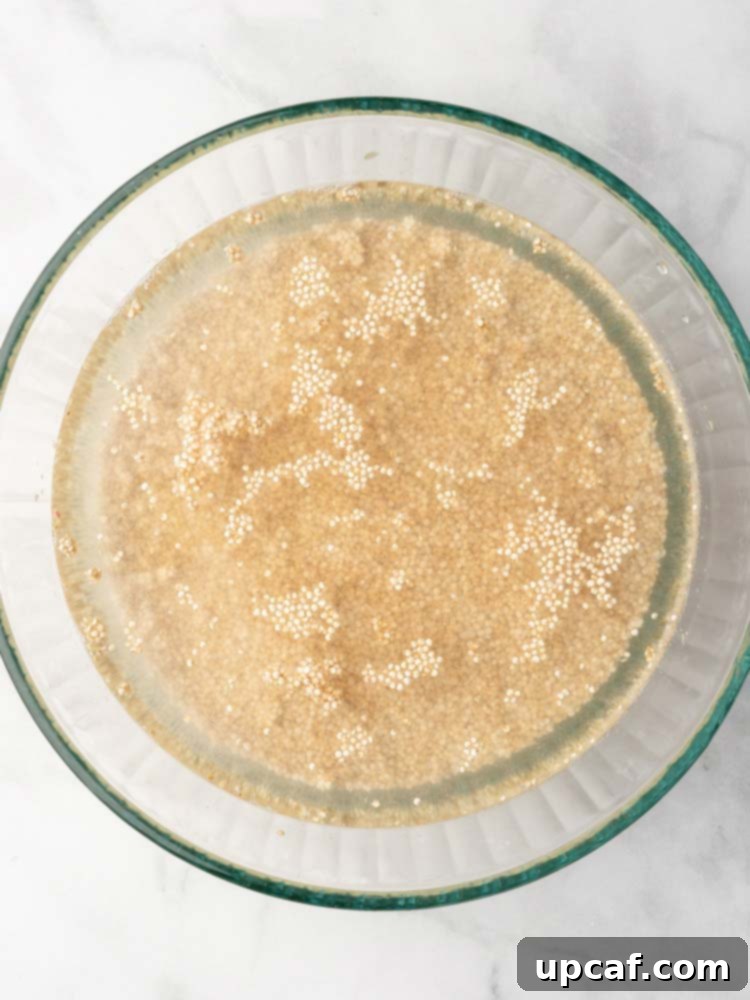
How to Cook Quinoa: Four Versatile Methods for Perfect Results
1. Stove Top Quinoa: The Classic and Reliable Method
Cooking quinoa on the stove top is perhaps the most traditional and commonly used method. It offers excellent control over the cooking process and consistently yields perfectly fluffy quinoa. The key is to maintain a gentle simmer and allow sufficient resting time.
- Rinse Quinoa: Begin by thoroughly rinsing 1 cup of quinoa in a fine-mesh colander under cold running water for at least 30 seconds until the water runs clear. Drain well.
- Combine Ingredients: In a medium saucepan (preferably with a tight-fitting lid), combine the rinsed quinoa with 1 ¾ cups of water or low-sodium vegetable broth. Add ½ teaspoon of salt and 1 teaspoon of olive oil (optional, but adds a nice flavor and helps prevent sticking).
- Bring to a Boil: Place the saucepan over medium-high heat and bring the mixture to a rolling boil.
- Simmer: Once boiling, reduce the heat to low, cover the saucepan tightly with its lid, and simmer gently for 15 minutes. Avoid lifting the lid during this time, as it lets out essential steam.
- Rest: After 15 minutes, remove the pot from the heat (keeping the lid on) and let it rest for another 5-10 minutes. This crucial resting period allows the quinoa to absorb any remaining liquid and ensures a fluffy, separated texture.
- Fluff and Serve: Remove the lid, and gently fluff the cooked quinoa with a fork. You should see tiny, white spirals (the germ) popping out from each grain, indicating it’s perfectly cooked. Serve immediately or use in your favorite recipes.
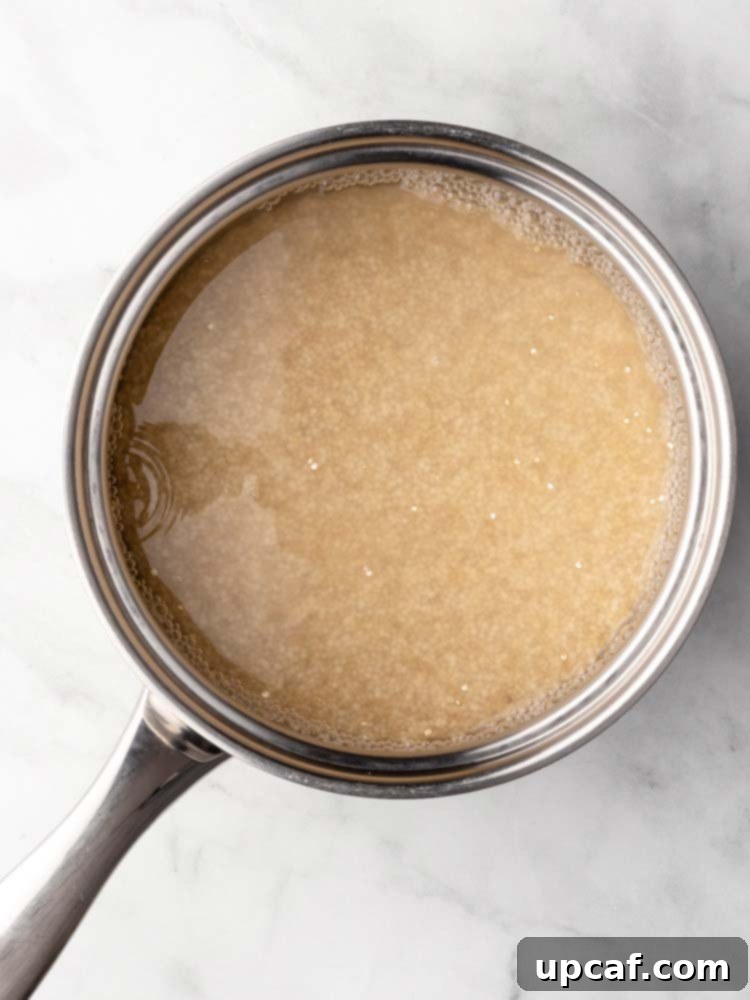
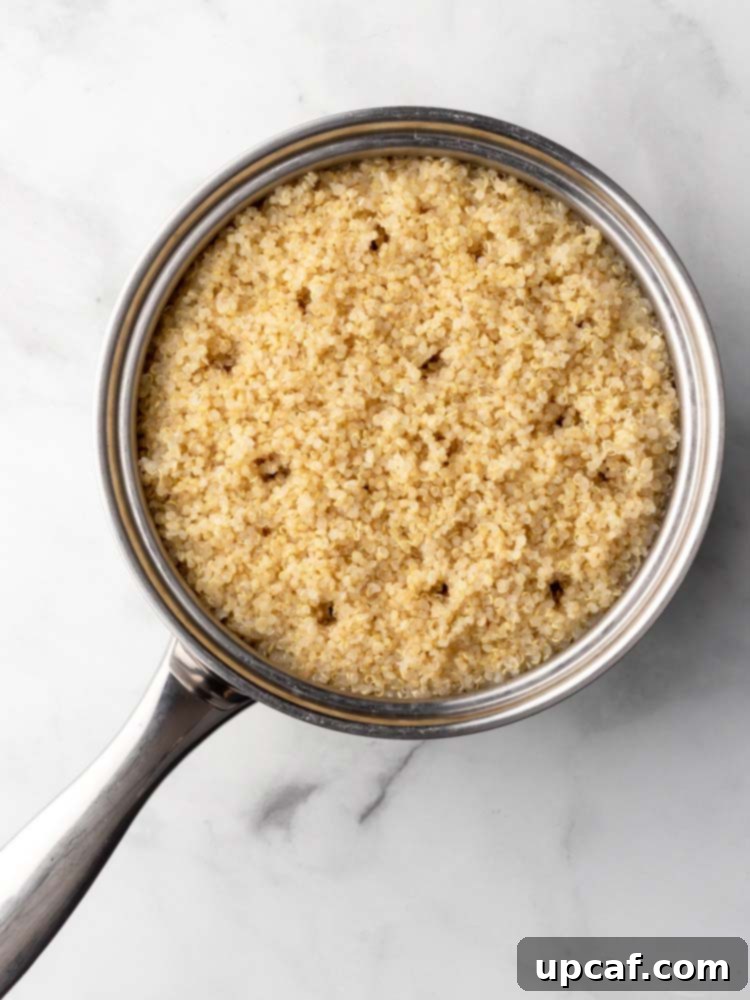
2. Effortless Rice Cooker Quinoa: Set It and Forget It!
For unparalleled convenience, cooking quinoa in a rice cooker is a game-changer. This method requires minimal supervision and yields consistent, fluffy results every time. Most modern rice cookers have specific settings for various grains, or you can simply use the standard “white rice” setting.
- Rinse Quinoa: As always, thoroughly rinse 1 cup of quinoa in a fine-mesh colander under cold running water for at least 30 seconds until clear. Drain completely.
- Combine in Rice Cooker: Transfer the rinsed quinoa to the rice cooker pot. Add 1 ¾ cups of water or broth, ½ teaspoon of salt, and 1 teaspoon of olive oil (optional). Stir briefly to combine all ingredients.
- Cook: Close the lid, select the appropriate setting (usually “white rice” or a dedicated “quinoa” setting if available), and press start. The rice cooker will automatically manage the cooking time, typically ranging from 15 to 30 minutes, and switch off when done.
- Rest: Once the rice cooker turns off, allow the quinoa to rest, covered, for an additional 5-10 minutes. This resting period helps firm up the grains and absorb any lingering moisture, preventing mushiness.
- Fluff and Serve: Open the lid, and gently fluff the cooked quinoa with a fork to separate the grains. Your perfectly cooked, fluffy quinoa is now ready to enjoy!
3. Speedy Instant Pot Quinoa: Quick and Consistent Pressure Cooking
The Instant Pot or any electric pressure cooker is fantastic for cooking quinoa quickly and efficiently. The high-pressure environment ensures even cooking and consistent texture, making it perfect for busy weeknights or large-batch meal prep.
- Rinse Quinoa: Rinse 1 cup of quinoa thoroughly under cold running water in a fine-mesh colander for at least 30 seconds. Drain completely.
- Prepare Instant Pot: Lightly spray the inner pot of your Instant Pot with a non-stick cooking spray or a thin layer of oil. This helps prevent sticking and makes cleanup easier.
- Combine Ingredients: Add the rinsed quinoa, 1 ½ cups of water or broth (note the slightly lower liquid ratio for pressure cooking), ½ teaspoon of salt, and 1 teaspoon of olive oil (optional) to the prepared Instant Pot.
- Seal and Cook: Secure the lid and ensure the steam release valve is set to the “Sealing” position. Press the “Manual” or “Pressure Cook” button, and set the cooking time to 1 minute on high pressure. The Instant Pot will take about 5-10 minutes to build pressure before the cooking cycle begins.
- Natural Release: Once the 1-minute cooking cycle is complete, allow the pressure to release naturally for 10 minutes. This means do not touch the steam release valve; let the pressure drop on its own. After 10 minutes, carefully move the steam release valve to “Venting” to quick-release any remaining pressure.
- Fluff and Serve: Carefully open the lid. Fluff the quinoa with a fork to separate the grains. Enjoy your perfectly cooked Instant Pot quinoa!
4. Quick Microwave Quinoa: When Time is of the Essence
For the fastest way to cook a small batch of quinoa, the microwave is surprisingly effective. This method is ideal for single servings or when you’re truly pressed for time, but it requires a large bowl to prevent boil-overs.
- Rinse Quinoa: Rinse 1 cup of quinoa under cold running water in a fine-mesh colander for at least 30 seconds until clear. Drain well.
- Combine in Microwave-Safe Bowl: In a large, deep, microwave-safe bowl (at least 2-quart capacity to prevent boiling over), combine the rinsed quinoa with 1 ¾ cups of water or broth, ½ teaspoon of salt, and 1 teaspoon of olive oil (optional).
- First Cook: Cover the bowl loosely with a microwave-safe plate or plastic wrap (vented) and microwave on high power for 6 minutes.
- Second Cook and Rest: Carefully remove the bowl from the microwave, stir the quinoa, and re-cover. Return to the microwave and cook for another 2 minutes on high. After this, let the bowl rest, still covered, for 5-10 minutes to allow the quinoa to absorb all the remaining liquid and steam.
- Fluff and Serve: Carefully remove the cover, fluff the quinoa with a fork, and serve.
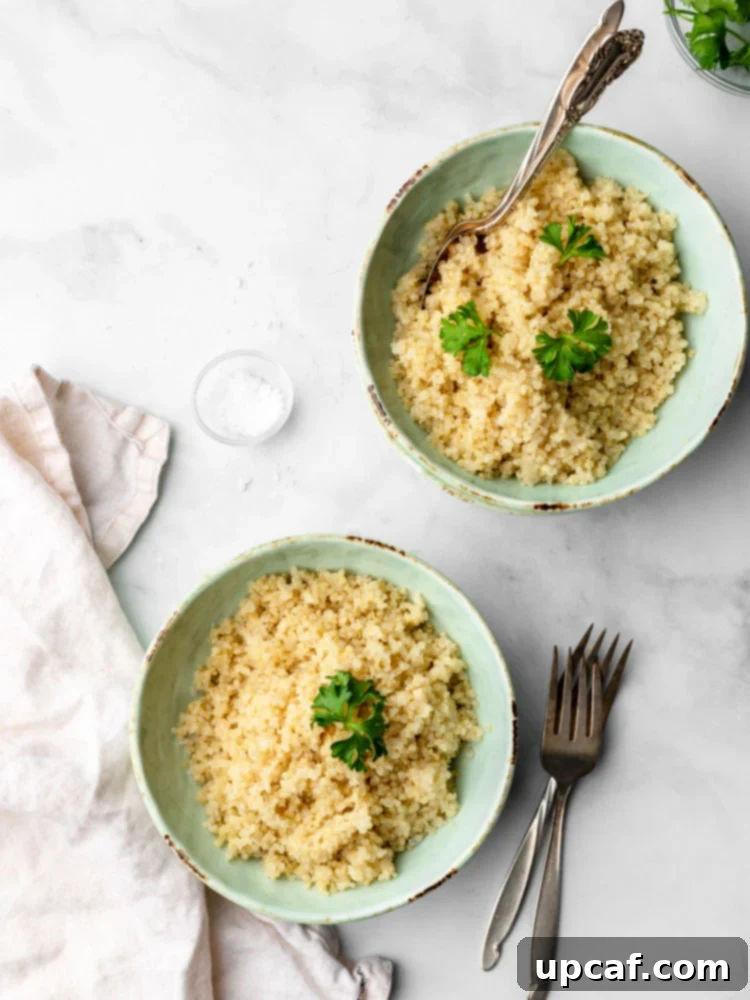
Frequently Asked Questions About Cooking Quinoa
What’s the Ideal Quinoa to Water Ratio?
For most cooking methods (stove top, rice cooker, microwave), the ideal ratio is 1 cup of dry quinoa to 1 ¾ cups of liquid. For pressure cooking methods like the Instant Pot, a slightly lower ratio of 1 cup of dry quinoa to 1 ½ cups of liquid is recommended to prevent it from becoming too soft. You can use plain water for a neutral flavor, or opt for low-sodium vegetable or chicken broth to infuse your quinoa with extra richness and savory notes. Experiment with different broths to find your favorite!
Do You Really Have to Rinse Quinoa? What Happens If You Don’t?
Yes, rinsing quinoa is a highly recommended and crucial step. Quinoa seeds naturally have a coating called saponin, a bitter, soapy-tasting compound. While many packaged quinoas are pre-rinsed, a quick rinse at home ensures any residual saponin is removed. If you skip rinsing, your cooked quinoa might have a distinctively bitter, slightly chemical, or soapy aftertaste that can detract from its natural nutty flavor. It’s a small step that makes a big difference in the final taste and enjoyment.
How Do You Know When Quinoa is Perfectly Cooked?
The best indicator that your quinoa is cooked to perfection is visual: look for a tiny, translucent spiral that “pops” out from each seed, resembling a small white halo or tail. This is the germ of the seed separating from the endosperm. In addition to this visual cue, the quinoa should be tender yet still have a slight al dente chew, similar to perfectly cooked pasta. There should be no standing water in the pot.
Is Quinoa Better Than Rice? A Nutritional Comparison
When comparing quinoa and rice, “better” often depends on your specific dietary goals and preferences. From a nutritional standpoint, quinoa generally holds an advantage. It boasts a significantly higher protein content, including all nine essential amino acids, making it a complete protein. Quinoa also contains more fiber, which is beneficial for digestion and satiety, and a broader array of essential minerals like magnesium, phosphorus, and iron. While both are healthy carbohydrates, quinoa offers a more nutrient-dense profile, making it a healthier option if you’re looking to maximize nutritional intake. For flavor and texture, it’s entirely a matter of personal preference; some prefer the mildness of rice, while others appreciate quinoa’s nutty flavor and slightly chewy texture.
How Long Does Cooked Quinoa Last and Can You Freeze It?
Cooked quinoa is excellent for meal prep and stores remarkably well. Once cooked, allow it to cool completely before transferring it to an airtight container. Stored this way, cooked quinoa will last for up to 5-7 days in the refrigerator. For longer storage, you can easily freeze cooked quinoa. Portion it into freezer-safe bags or containers and freeze for up to 8-12 months. When ready to use, simply thaw overnight in the refrigerator or reheat directly from frozen in the microwave or on the stovetop with a splash of water or broth to rehydrate. Frozen quinoa is perfect for quick additions to salads, bowls, or as a side dish.
Beyond the Bowl: Delicious Ways to Enjoy Cooked Quinoa
Cooked quinoa’s mild, nutty flavor and versatile texture make it a fantastic addition to almost any meal. Here are just a few ideas to inspire your culinary creativity:
- Salads: From vibrant cold salads with fresh vegetables and vinaigrette to warm grain salads with roasted vegetables, quinoa adds substance and nutrition.
- Breakfast Bowls: Use it as a base for a hearty breakfast porridge, topped with fruits, nuts, and a drizzle of honey or maple syrup.
- Stir-Fries and Bowls: Replace rice in your favorite stir-fry or grain bowl recipes.
- Stuffed Vegetables: A fantastic filling for bell peppers, zucchini, or even mushrooms, mixed with herbs, cheese, and other vegetables.
- Patties and Burgers: Combine with beans, vegetables, and spices to create delicious vegetarian burgers or patties.
- Soups and Stews: Add cooked quinoa to thicken and boost the nutritional content of your favorite soups and stews.
- Side Dish: A simple, healthy alternative to rice or potatoes alongside grilled proteins or roasted vegetables.
Recipes Featuring Cooked Quinoa
Now that you’ve mastered the art of cooking quinoa, put your skills to delicious use with these inspiring recipes:
- Mediterranean Quinoa Salad
- Caribbean Jerk Fish Bowl
More Culinary Tutorials from Cookin’ With Mima
Continue to expand your kitchen repertoire with these other helpful guides:
- How to Cook Cauliflower Rice
- How to Bake Potatoes
- How to Poach an Egg
- How to Make Perfect Hard Boiled Eggs

I sincerely hope this detailed guide empowers you to confidently cook and enjoy quinoa using any of these simple methods. Embracing quinoa in your diet is a delicious step towards healthier eating and more efficient meal preparation. Experiment with these techniques and discover the joy of this incredible superfood!
If you try any of these methods or create a delicious quinoa recipe, please share it with me on INSTAGRAM using my hashtag for a chance to be featured! Stay connected with Cookin’ With Mima on FACEBOOK, INSTAGRAM, and PINTEREST for all my latest recipes, tips, and culinary inspiration. Happy cooking!
